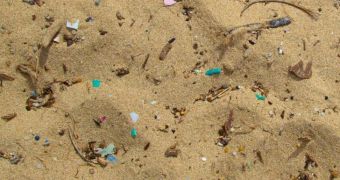Investigations carried out over the years have shown that bits and pieces of plastic that end up in our planet's seas and oceans constitute a threat to wildlife inhabiting marine ecosystems. Interestingly enough, researchers now claim that these particles are way more dangerous than assumed.
In a paper published in the journal Environmental Science and Technology, specialists with the University of Exeter in the United Kingdom and fellow researchers explain that microplastics affect marine dwellers in more than one way.
Simply put, these scientists say that, according to evidence at hand, teeny tiny plastic fragments can enter the body of one animal or another not just through the mouth, while the unsuspecting creatures are busy enjoying breakfast, lunch or dinner.
On the contrary, microplastics can also work their way into a marine creature's organism through the gills, i.e. respiratory organs that work by extracting oxygen from water and releasing carbon dioxide, the University of Exeter researchers explain.
The bad news is that, when compared to plastic fragments that enter the body through the mouth, those absorbed through the gills take much longer to return to the ocean. Because they linger on in an animal's organism for considerable periods of time, they tend to cause more damage.
More precisely, they have high chances to impair the animal's ability to extract oxygen from the water. These respiratory issues can, be it only once in a while, lead to serious medical complications, maybe even death, specialists explain in the journal Environmental Science and Technology.
Besides, it appears that, because they stick around for much longer than microplastics entering the body through the mouth, plastic fragments absorbed through an animal's gills are more likely to work their way up the food chain, and even reach humans who like to eat fish or seafood.
“Many studies on microplastics only consider ingestion as a route of uptake into animals. The results we have just published stress other routes such as ventilation. We have shown this for crabs, but the same could apply for other crustaceans, molluscs and fish.”
“This is highly important from an ecological point of view, as if these plastics are retained longer within the animal there is more chance of them being passed up the food chain,” study lead author Dr. Andrew Watts commented on these findings in a statement.
It is estimated that, in this day and age, human society uses about 288 million tonnes of plastic on a yearly basis. Of the plastic material that gets thrown away, approximately 10% fails to reach landfills and instead ends up in seas and oceans. Here, it gets broken down and turns into small particles that scientists call microplastics.

 14 DAY TRIAL //
14 DAY TRIAL //